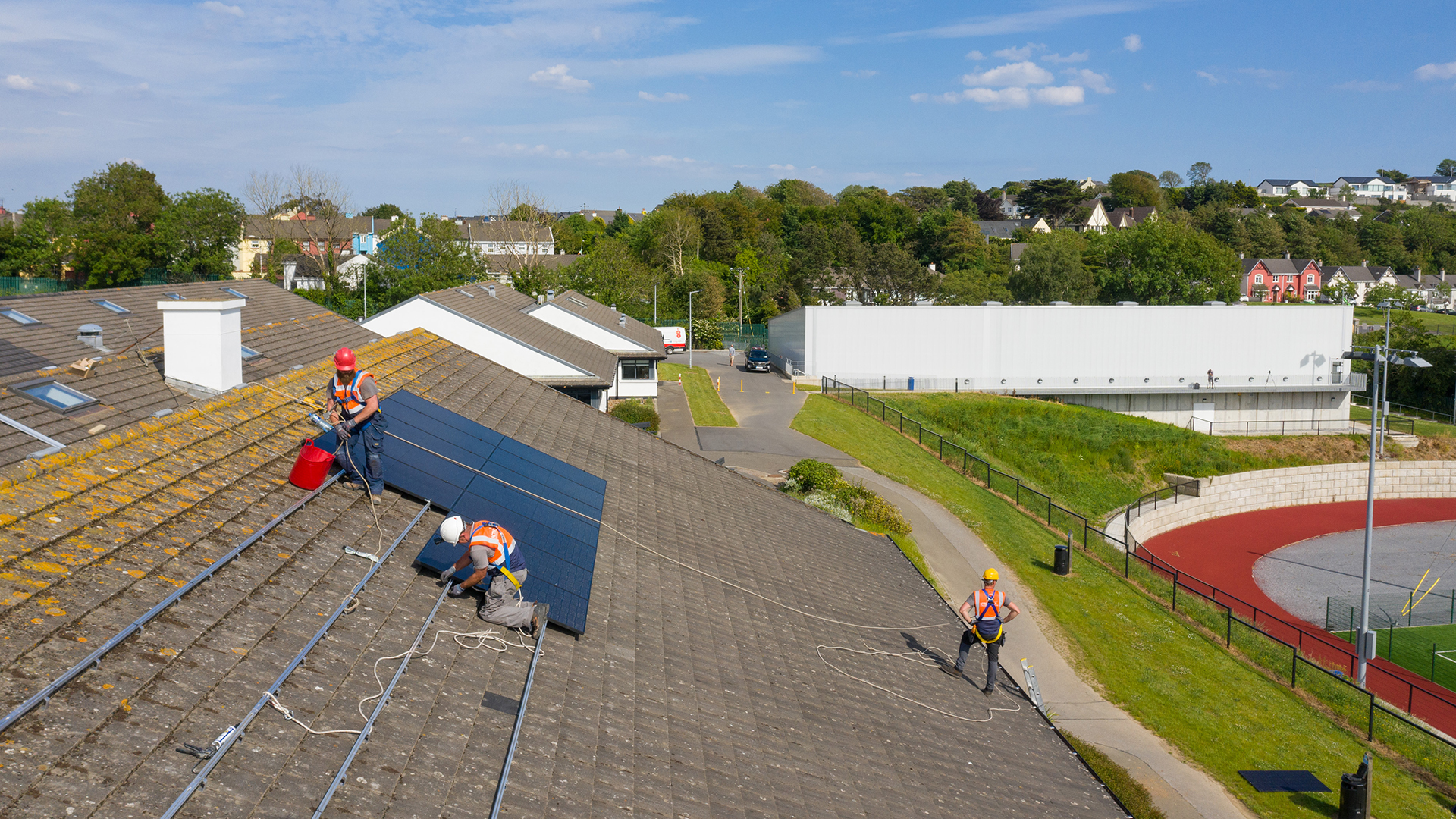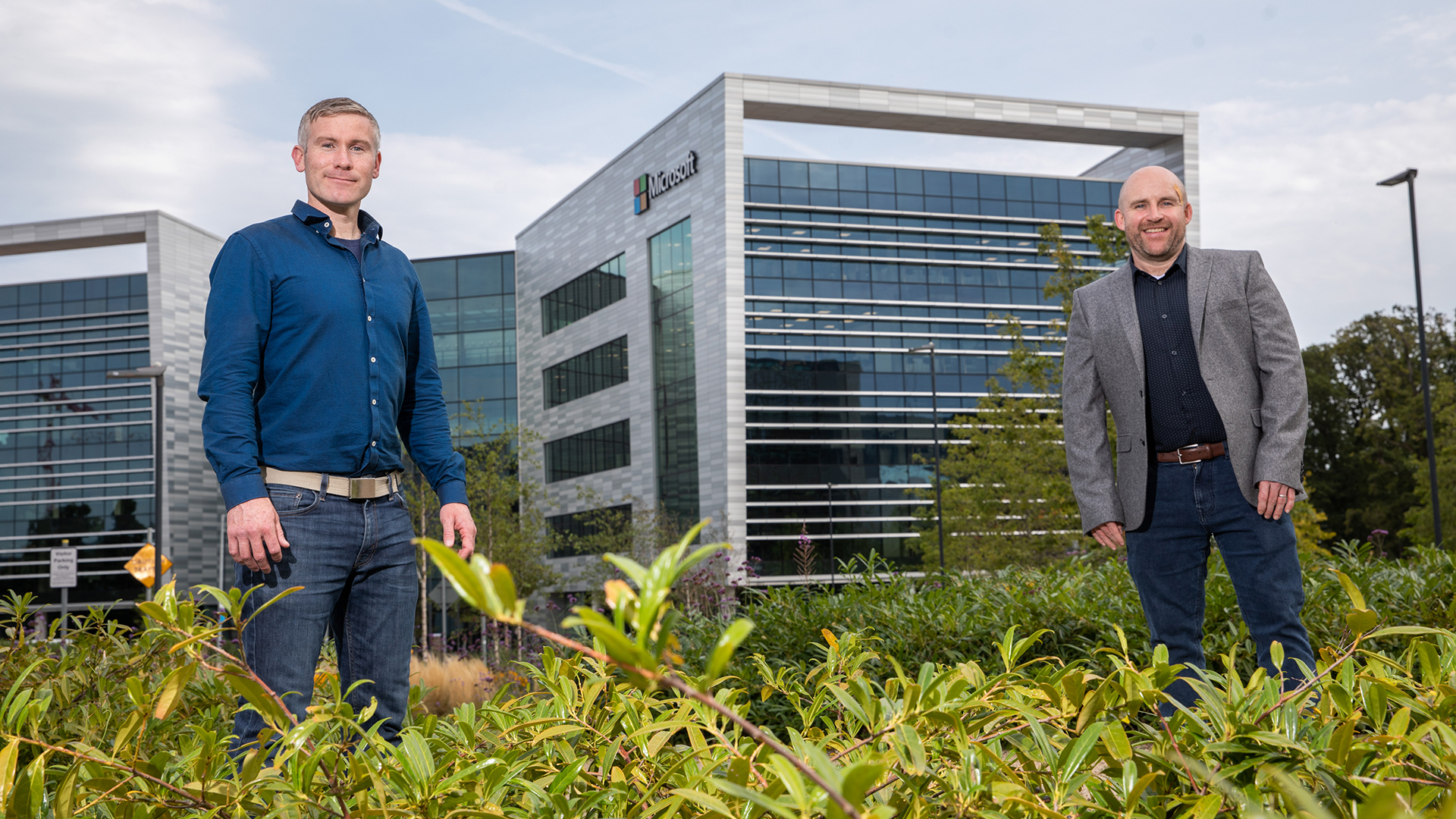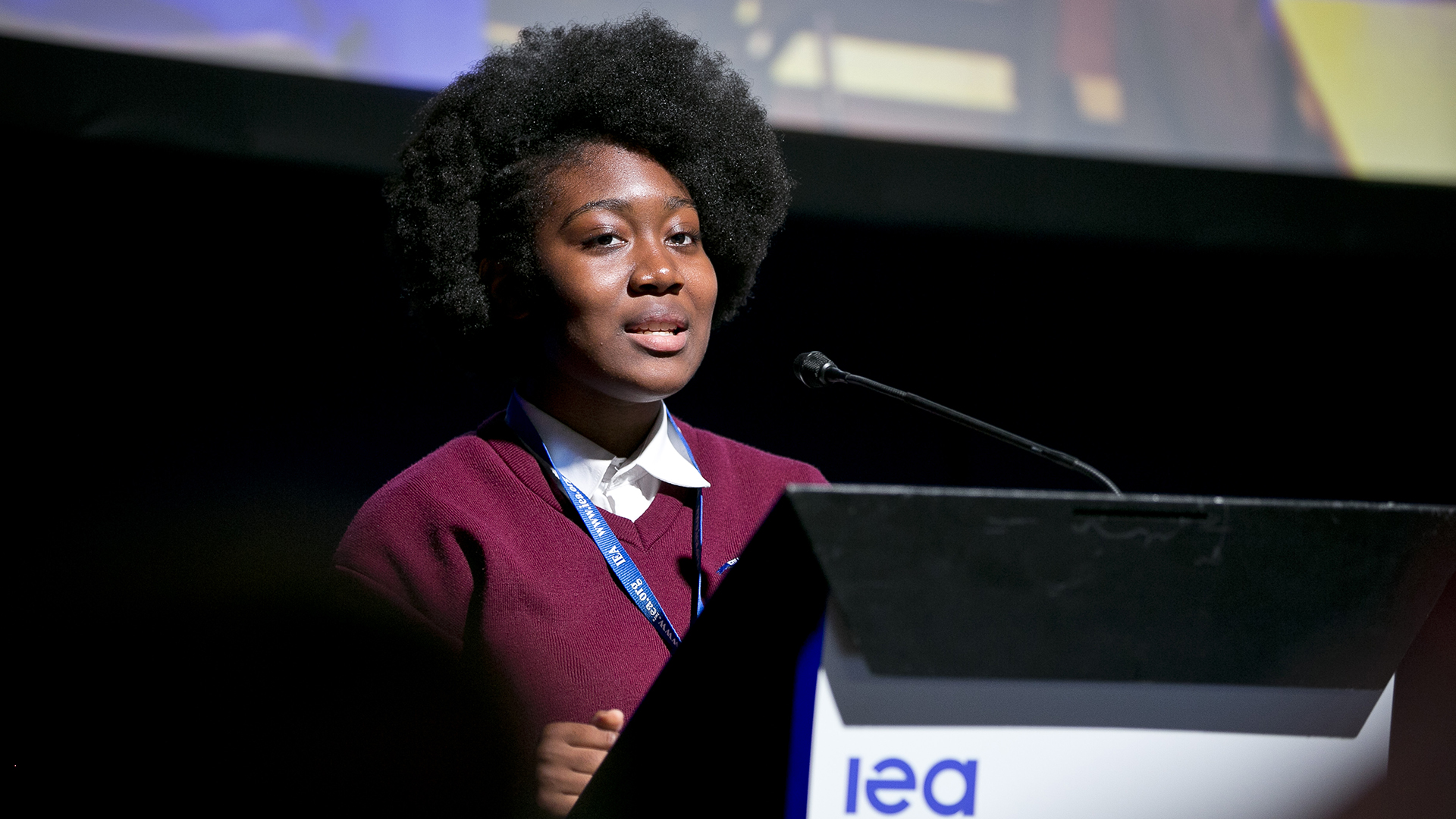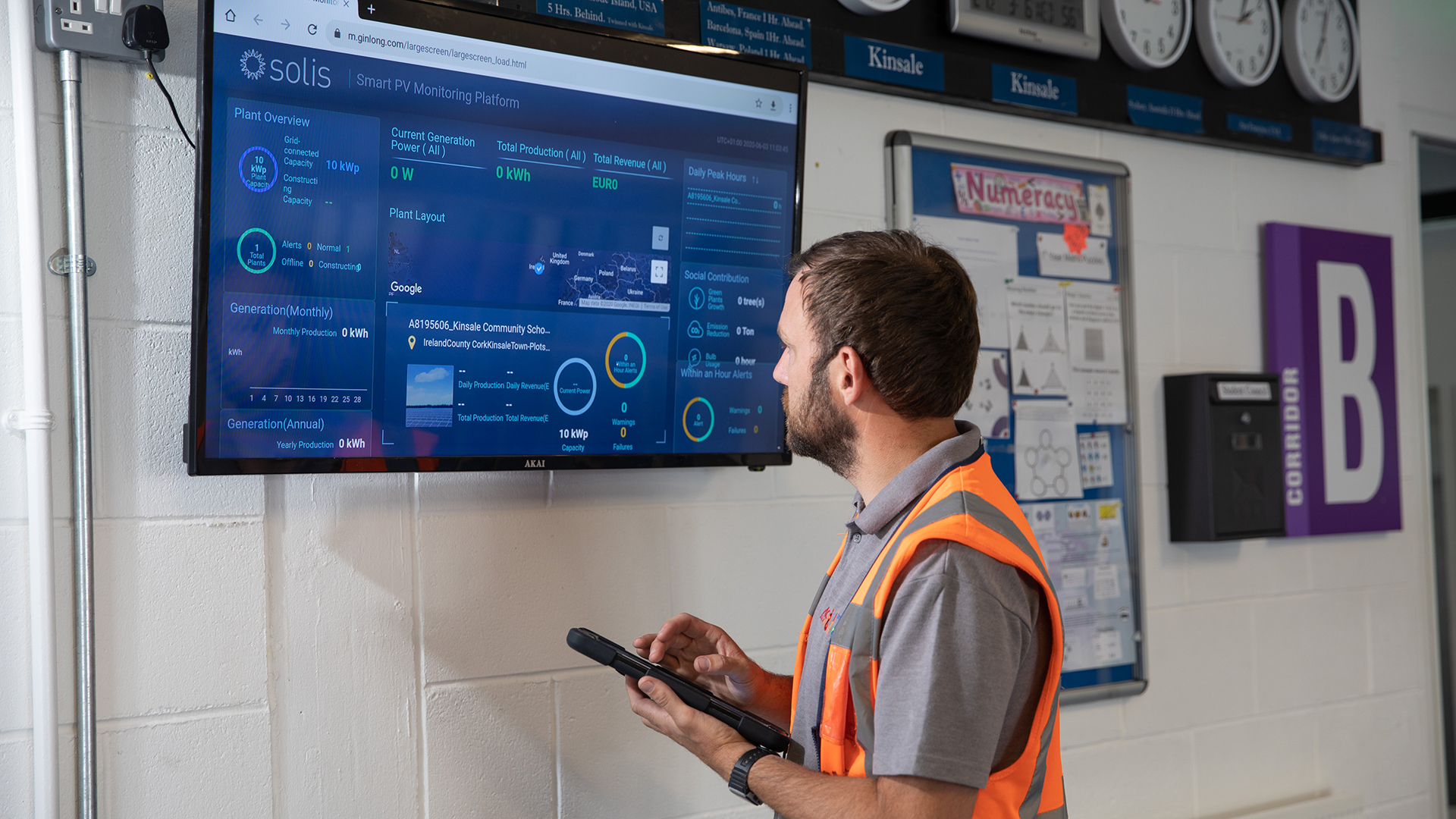
Microsoft demonstrates how to increase green energy in Ireland one rooftop at a time
Solar panels being installed on the roofs of dozens of schools throughout Dublin, Ireland, reflect a novel front in the fight against global climate change, according to a senior software engineer and a sustainability lead at Microsoft.
The technology company partnered with SSE Airtricity, Ireland’s largest provider of 100% green energy and a part of FTSE listed SSE Group, to install and manage the internet-connected solar panels, which are connected via Azure IoT to Microsoft Azure, a cloud computing platform.
The software tools aggregate and analyze real-time data on energy generated by the solar panels, demonstrating a mechanism for Microsoft and other corporations to achieve sustainability goals and reduce the carbon footprint of the electric power grid.
“We need to decarbonize the global economy to avoid catastrophic climate change,” said Conor Kelly, the software engineer who is leading the distributed solar energy project for Microsoft Azure IoT. “The first thing we can do, and the easiest thing we can do, is focus on electricity.”
Microsoft’s $1.1 million contribution to the project builds on the company’s ongoing investment in renewable energy technologies to offset carbon emissions from the operation of its datacenters.
A typical approach to power datacenters with renewable energy is for companies such as Microsoft to sign so-called power purchase agreements with energy companies. The agreements provide financial guarantees needed to build industrial-scale wind and solar farms and connections to the power grid.
The new project demonstrates the feasibility of agreements to install solar panels on rooftops distributed across towns with existing grid connections and use internet of things, or IoT, technologies to aggregate the accumulated energy production for carbon offset accounting.
“It utilizes existing assets that are sitting there unmonetized, which are roofs of buildings that absorb sunlight all day,” Kelly said.

Conor Kelly, left, a senior software engineer and sustainability lead at Microsoft, and Fergal Ahern, right, a business energy solutions manager and renewable energy expert with SSE Airtricity, stand outside a Microsoft office in Dublin, Ireland. The two companies partnered on a project to demonstrate the feasibility of distributed power purchase agreements. Photo by Naoise Culhane.
New business model
The project is also a proof-of-concept, or blueprint, for how energy providers can adapt as the falling price of solar panels enables distributed electric power generation throughout the existing electric power grid.
Traditionally, suppliers purchase power from central power plants and industrial-scale wind and solar farms and sell it to consumers on the distribution grid. Now, energy providers like SSE Airtricity provide renewable energy solutions that allow end consumers to generate power, from sustainable sources, using the existing grid connection on their premises.
“The more forward-thinking energy providers that we are working with, like SSE Airtricity, identify this as an opportunity and industry changing shift in how energy will be generated and consumed,” Kelly noted.
The opportunity comes in the ability to finance the installation of solar panels and batteries at homes, schools, businesses and other buildings throughout a community and leverage IoT technology to efficiently perform a range of services from energy trading to carbon offset accounting.
Kelly and his team with Azure IoT are working with SSE Airtricity to develop the tools and machine learning models necessary to unlock this opportunity.
“Instead of having utility scale solar farms located outside of cities, you could have a solar farm at the distribution level, spread across a number of locations,” said Fergal Ahern, a business energy solutions manager and renewable energy expert with SSE Airtricity.
For the distributed power purchase agreement, SSE Airtricity uses Azure IoT to aggregate the generation of all the solar panels installed across 27 schools around the provinces of Leinster, Munster and Connacht and run it through a machine learning model to determine the carbon emissions that the solar panels avoid.
The schools use the electricity generated by the solar panels, which reduces their utility bills; Microsoft receives the renewable energy credits for the generated electricity, which the company applies to its carbon neutrality commitments.
The panels are expected to produce enough energy annually to power the equivalent of 68 Irish homes for a year and abate more than 2.1 million kilograms, which is equivalent to 4.6 million pounds, of carbon dioxide emissions over the 15 years of the agreement, according to Kelly.
“This is additional renewable energy that wouldn’t have otherwise happened,” he said. “Every little bit counts when it comes to meeting our sustainability targets and combatting climate change.”

Victory Luke, a student at Collinstown Park Community College in Dublin, Ireland, gave a speech about combatting climate change at the 2019 Global Conference on Energy Efficiency, which was organized by the International Energy Agency. Photo by Fennell Photography.
Every little bit counts
Victory Luke, a 16 year old student at Collinstown Park Community College in Dublin, has lived by the “every little bit counts” mantra since she participated in a “Generation Green” sustainability workshop in 2019 organized by the Sustainable Energy Authority of Ireland, SSE Airtricity and Microsoft.
The workshop was part of an education program surrounding the installation of solar panels and batteries at her school along with a retrofit of the lighting system with LEDs. Digital screens show the school’s energy use in real time, allowing students to see the impact of the energy efficiency upgrades.
Luke said the workshop captured her interest on climate change issues. She started reading more about sustainability and environmental conservation and agreed to share her newfound knowledge with the younger students at her school.
“I was going around and talking to them about energy efficiency, sharing tips and tricks like if you are going to boil a kettle, only boil as much water as you need, not too much,” she explained.
That June, the Sustainable Energy Authority of Ireland invited her to give a speech at the Global Conference on Energy Efficiency in Dublin, which was organized by the International Energy Agency, an organization that works with governments and industry to shape sustainable energy policy.
“It kind of felt surreal because I honestly felt like I wasn’t adequate enough to be speaking about these things,” she said, noting that the conference attendees included government ministers, CEOs and energy experts from around the world.
At the time, she added, the global climate strike movement and its youth leaders were making international headlines, which made her advocacy at school feel even smaller. “Then I kind of realized that it is those smaller things that make the big difference,” she said.
SSE Airtricity and Microsoft plan to replicate the educational program that inspired Luke and her classmates at dozens of the schools around Ireland that are participating in the project.
“When you’ve got solar at a school and you can physically point at the installation and a screen that monitors the power being generated, it brings sustainability into daily school life,” Ahern said.

Brian McCloskey with green energy provider SSE Airtricity checks out a dashboard inside Kinsale Community School in Kinsale, Ireland. The dashboard monitors energy generated by solar panels installed on the school’s roof as part of a project with Microsoft to demonstrate the feasibility of distributed power purchase agreements. Photo by Naoise Culhane.
Proof of concept for policymakers
The project’s education campaign extends to renewable energy policymakers, Kelly noted. He explained that renewable energy credits – a market incentive for corporations to support renewable energy projects – are currently unavailable for distributed power purchase agreements.
For this project, Microsoft will receive genuine renewable energy credits from a wind farm that SSE Airtricity also operates, he added.
“And,” he said, “we are hoping to use this project as an example of what regulation should look like, to say, ‘You need to award renewable energy credits to distributed generation because they would allow corporates to scale-up this type of project.’”
For her part, Luke supports steps by multinational corporations such as Microsoft to invest in renewable energy projects that address global climate change.
“It is a good thing to see,” she said. “Once one person does something, other people are going to follow.”
Top image: SSE Airtricity employees Derek Conty, left, Francie Byrne, middle, and Ryan Doran, right, install solar panels on the roof of Kinsale Community School in Kinsale, Ireland. The installation is part of a project with Microsoft to demonstrate the feasibility of distributed power purchase agreements. Photo by Naoise Culhane.
Related
- Watch: Microsoft & SSE Airtricity: Exploring Energy Saving & Carbon Reduction Opportunity of Solar
- Learn more about Microsoft Azure IoT for energy
- Check out the carbon neutral and sustainable operations program at Microsoft
- Read: Building for the future: Microsoft’s new Swedish datacenters have sustainability in mind
- Read: Microsoft finds underwater datacenters are reliable, practical and use energy sustainably
- Learn more about Conor Kelly in a story about Microsoft employees making a difference
- Read: Microsoft tests hydrogen fuel cells for backup power at datacenters
John Roach writes about Microsoft research and innovation. Follow him on Twitter.
